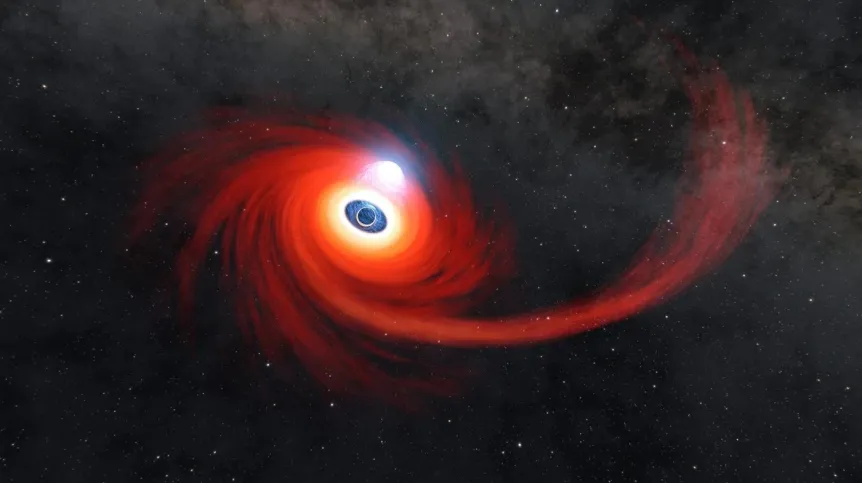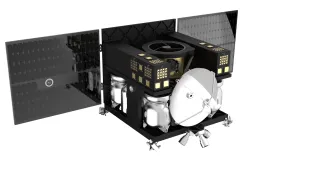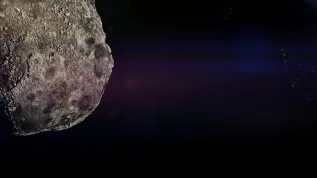
A team of astrophysicists has identified a new, long-lasting source of gravitational waves: subgiant stars that are gradually stripped of their outer layers by nearby supermassive black holes.
The signal, which could last hundreds of thousands or even millions of years, falls within the frequency range detectable by the future LISA space observatory, the researchers report in The Astrophysical Journal Letters. First author of the paper, Dr. Aleksandra Olejak from the Max Planck Institute for Astrophysics in Munich, told the Polish Press Agency: “We were looking for stars that could survive the gradual stripping of matter by a nearby supermassive black hole without being completely torn apart.
From LIGO to LISA: Expanding the gravitational wave spectrum
Gravitational waves, ripples in spacetime caused by accelerating massive objects, are currently detected by ground-based instruments such as LIGO in the United States and Virgo in Italy. These detectors are sensitive to high-frequency waves resulting from events like black hole mergers or neutron star collisions.
The upcoming Laser Interferometer Space Antenna (LISA), planned for launch by the European Space Agency in 2037, will mark a significant leap in gravitational wave astronomy. Composed of three satellites flying in a triangular formation 2.5 million kilometres apart, LISA will orbit the Sun and detect lower-frequency gravitational waves from massive systems, such as binary stars and supermassive black hole interactions.
A new gravitational wave source: Subgiant–black hole binaries
According to the new study, a previously overlooked source of gravitational waves could be a system composed of a supermassive black hole, one million times the mass of the Sun, and a subgiant star.
“A subgiant is a star that has exhausted its core hydrogen and is burning hydrogen in the envelope surrounding the core, but has not yet fully become a red giant,” Olejak said. “Its core is already helium and compact, and its hydrogen envelope is gradually expanding.”
The researchers found that if such a star were captured into a close orbit around a supermassive black hole, the intense gravity of the black hole could gradually strip away the star’s hydrogen envelope. This process would lead to continuous gravitational wave emission—precisely the kind LISA is designed to detect.
A million-year signal
“Our simulations show that the emission of gravitational waves in such a system could last for hundreds of thousands or even up to a million years,” said Olejak. “What’s more, if the hydrogen in the thin envelope re-ignites, it could lead to a rapid expansion of the star’s radius and intense mass transfer episodes to the black hole. These events could also produce electromagnetic radiation.”
Such a system would qualify as a “multimessenger source,” meaning it emits both gravitational and electromagnetic signals, allowing scientists to observe it using a variety of astronomical tools. “If the spin of a supermassive black hole is very high, then a disruption of the stellar core just outside the event horizon could also be observed in the electromagnetic spectrum,” she added.
Peering into the hidden hearts of galaxies
“Supermassive black holes are usually located at the centres of galaxies, and they are often surrounded by dense gas and dust that blocks visible light,” Olejak noted. “So far, it has been very difficult to look directly into the vicinity of their event horizons. Gravitational waves, which are not absorbed by matter, can give us invaluable information about the processes happening in those regions.”
She added that observations by X-ray telescopes have already detected periodic outbursts near supermassive black holes. “One hypothesis suggests that their source may be such systems, in which the black hole periodically ‘eats’ the outer layers of the star.”
“Any system in which two massive objects are accelerating relative to each other emits gravitational waves—usually ones that are extremely subtle and impossible to measure,” she explained. “However, in the case of supermassive black holes with a subgiant companion, thanks to the unique structure of such a star, the signal can be so strong that—thanks to LISA—it can be detected from distances reaching billions of light-years.”
PAP - Science in Poland, Ludwika Tomala
lt/ agt/













